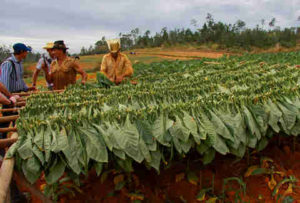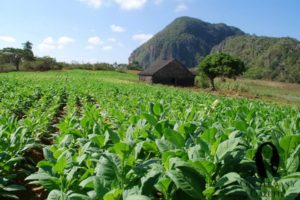In Cuba and around the world tobacco is today a high expression for its quality and it has been that way for many years.
The Cuban aborigines consumed tobacco long before the arrival of the Genoese Admiral Christopher Columbus. Studies and evidence show that our natives used it as a medicine, narcotic, aphrodisiac, for rituals and religious celebrations. They smoked it, sucked it up the nose, anointed it on the body, used it in eye drops and enemas, and even drank it in concoctions.
When Columbus returned to Europe in 1492 after discovering Cuba, his caravels, which had no chimneys, returned smoking to the old continent. The navigator saw in the Cuban Indians the man smoking for the first time. From there the habit jumped into the next world. So that of the tobacco industry is not only the first of America, but began in Cuba.
Rodrigo de Jerez was one of the sailors who arrived in the Americas with Columbus and returned to old Europe with the habit of smoking. The inquisition, after claiming that only the devil could grant a man the power to draw smoke through his mouth, sanctioned him accused of witchcraft, to seven years’ imprisonment.
In fact, the first modality of tobacco consumption in Europe was snuff, dry tobacco that especially the ladies wore attached to the wrist in a leather bag. It was believed that sniffing snuff removed the migraine, so it was called Aroma de la Reina. Then, at some point, the Europeans began to smoke cigarettes – or habanos – as such, and then the cigarette appeared.
Note the words “cohiba” and “tobacco” used by Colón in his diary. It is believed that “cohiba” is the Taino word for the roll of dry leaves that smoked, the first name of the cigar. And “tobacco” was the name of the tube in the form of “Y” with which the Indians aspired tobacco powder, although today is the word used in Cuba to designate a cigar or habano.
Nevertheless the taste for the tobacco prevailed and this one became an industry and although the scholars are clear that this plant has its origin in the Andean zone between Peru and Ecuador, the Cuban tobacco quickly reached the qualification of “the best one of the world”. And the term habano appeared to conceptualize all the cigars, where 100% of the product is cultivated and manufactured in Cuba after multiple and severe controls at the level of culture as of drying and twisting.
It is said that the quality of the habano lies in the union of four factors: the climate; soil; The wisdom of Cuban peasants and supporters; And varieties of the Cuban black tobacco type. The denominations of origin are not for taste, reason of more they give the Cuban tobacco and Rum.
In spite of the attempts already made to reach the quality of an authentic Havana in other regions of the planet from a seed of Cuban origin, the quality of the tobacco made in Cuba is never reached. The combination of climatic factors with the characteristics of the Cuban territory make Havana an authentic product of Cuba, certified by the seal that adorns the boxes of the different Cuban brands.
Tobacco in all its projections crosses diametrically through the history of Cuba. This was demonstrated so masterfully Fernando Ortiz in his work “The Cuban Contrapunteo of Sugar and Tobacco”, in which parallel to the green leaf, the sweet daughter of the cane is defined as another crucial protagonist of the essence of La Isla.
Cuba y el inicio del uso Internacional del Tabaco.
En Cuba el tabaco se le concede hoy como máxima la expresión de su calidad y ha sido así por muchos años.
Los aborígenes cubanos consumían el tabaco mucho antes de que llegara el almirante genovés Cristóbal Colón. Los estudios y evidencias, demuestran que nuestros indígenas lo usaban como medicamento, narcótico, afrodisíaco, para rituales y celebraciones religiosas. Lo fumaban, aspiraban por la nariz, lo untaban sobre el cuerpo, lo usaban en gotas en los ojos y en enemas, y hasta lo bebían en brebajes.
Cuando Colón regresó a Europa en 1492 después de descubrir Cuba, sus carabelas que no tenían chimeneas, volvieron echando humo al viejo continente. El navegante vio allí en los indios cubanos al hombre fumar por primera vez. Desde ahí el hábito saltó al otro mundo. De modo que de la industria tabacalera no sólo es la primera de América, sino que comenzó en Cuba.
Rodrigo de Jerez fue uno de los marineros que llegó a las Américas con Colón y regresó a la vieja Europa con el hábito de fumar. La inquisición, después de alegar que sólo el diablo podía conceder a un hombre el poder de sacar humo por la boca, le sancionó acusado de brujería, a siete años de prisión.
De hecho, la primera modalidad de consumo de tabaco en Europa fue el rapé, tabaco seco que sobre todo las damas llevaban sujetas a la muñeca en una bolsita de cuero. Se creía que oler el tabaco quitaba la migraña, por eso se le llamó Aroma de la Reina. Luego, en algún punto, los europeos comenzaron a fumar tabacos —o habanos— como tal, y después apareció el cigarrillo.
Hay que destacar las palabras “cohiba” y “tabaco” las utiliza Colón en su diario. Se cree que “cohiba” es la palabra taína que designaba al rollo de hojas secas que fumaban, el primer nombre del cigarro. Y “tabaco” era el nombre del tubo en forma de “Y” con el que los indios aspiraban tabaco en polvo, aunque hoy es la palabra que se usa en Cuba para designar a un puro o habano.
No obstante el gusto por el tabaco se impuso y éste se convirtió en industria y pese a que los estudiosos tienen claro que dicha planta tiene su origen en la zona andina entre Perú y Ecuador, el tabaco cubano alcanzó rapidamente el calificativo de “el mejor del mundo”. Y apareció el término habano para conceptualizar todos los puros, donde el 100% del producto es cultivado y manufacturado en Cuba tras múltiples y severos controles tanto a nivel de de cultivo como de secado y torcido.
Se dice que la calidad del habano radica en la unión de cuatro factores: el clima; el suelo; la sabiduría de los campesinos y torcedores cubanos; y las variedades del tipo de tabaco negro cubano. Las denominaciones de origen no son por gusto, razón de más la dan el tabaco y el ron cubanos.
A pesar de los intentos ya hechos de alcanzar la calidad de un auténtico habano en otras regiones del planeta a partir de una semilla de origen cubano, nunca se llega a la calidad del tabaco hecho en Cuba. La combinación de factores climáticos con las características del territorio cubano hacen del habano un producto auténtico de Cuba, certificado por el sello que adorna las cajas de las diferentes marcas cubanas.
El tabaco en todas sus proyecciones cruza diametralmente por la historia de Cuba. Así lo demostró de manera magistral Fernando Ortiz en su obra “El Contrapunteo Cubano del Azúcar y el Tabaco”, en el que paralelamente a la verde hoja, la dulce hija de la caña es definida como otra protagonista crucial de la esencia de La Isla.
Agencies/Memorias Cubanas/Internet Photos/Arnoldo Varona/TheCubanHistory.com
THE CUBAN HISTORY, HOLLYWOOD.



 > CUBA and the beginning of the International use of Tobacco. + CUBA y el inicio del uso Internacional del Tabaco.
> CUBA and the beginning of the International use of Tobacco. + CUBA y el inicio del uso Internacional del Tabaco.





